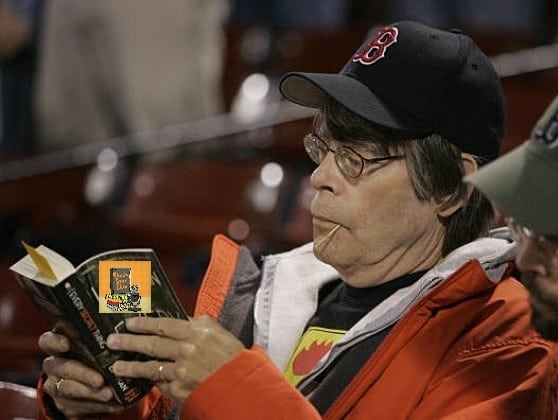5 Ingenious MLB Baseball Rule Change Proposals
We’re in the midst of a pretty exciting baseball season but why not throw a wrench into things and come up with some new baseball rules? What’s that ol’ saying? “If it ain’t broke, it will be soon, so you should fix it”.
You may be asking, ‘Why is a Book Club writing baseball articles?’ Well first off, we’re not just a book club, we’re really more like a cult. Only difference is our followers are more rabid and our membership is massive compared to your typical cult. Secondly, our boy Stephen King (ever heard of him?) crushes books at baseball games. So don’t lob these softball Timmy Wakefield knuckleball questions at us.

We wrote a blog about closer songs and immediately after closer songs (especially Edwin Diaz’s) became all the rage, coincidence? Yes, likely, but we’re guessing this blog will have a similar impact.
We recently saw this tweet from friend of the program, Big Cat, and it got us thinking.
This is a pretty great idea, but I for one am not going to sit here and let anyone out-ambitiously-dumb-sports rule me, so that’s why we’ve attempted to come up with 5 that are way more ambitiousous (it’s a word don’t look it up) and way dumber.
1. You Can Steal First Base

How it would work: If there are no runners on-base, at any point during an at-bat if the ball is in the pitchers hand the batter may drop his bat and sprint to first in an attempt to steal first base. To throw him out the pitcher must throw it to the catcher, the catcher must throw it to first for a force out. The runner may not run through first base.
Why: Pitchers have become too comfortable on the mound, using the rosin bag, rubbing up the baseball, shaking off calls, taking a quick bump of spider tack, and finally delivering their slow wind-up (at least we don’t have to deal with Hideo Nomo any more). There is no pressure on the pitchers, no worry at all with no one on-base, this will change that. It’ll put pressure on pitchers, add excitement at all times, and speed up the game.
Example: You’re Bobby Witt Jr., one of the fastest runners in baseball, but you’re in a little bit of a hitting rut and facing tough Cardinals relief pitcher, Giovanny Gallegos, a guy who takes the longest between pitches in the MLB. Want to spark a big inning and get into Giovanny’s head, book it down to first while Gallegos isn’t paying attention and get the lead-off hitter on base.
2. Lineups Can Reset Each Time Through the Order

How it would work: No lineup card needs to be submitted all 9 batters must bat, but once those 9 batters have batted they can bat in any order each proceeding time through the order.
Why: The fact that you must submit a lineup card I think is antiquated. It’d be like submitting your depth chart and formations you plan to use in a football game to your opponent and sticking with them the whole game. This new rule would allow for managers to employ a lot more strategy.
Example: It’s the third inning, the Yankees 9th hitter just walked to load the bases. Traditionally the leadoff hitter (probably DJ LeMahieu .788 OPS) would now come to the plate, but Aaron Boone being the shrewd fox that he is, instead sends HR leader Aaron Judge (1.050 OPS) to the plate. He hits a grand slam, smart play. Seeing that the right-handed pitcher is likely going to be taken out soon in favor of a long-relief left-hander, Boone proceeds to bat his lefty hitters Anthony Rizzo and Andrew Benintendi as the next two batters (typically something managers avoid). Just a lot more fun decision making moves and chess pieces to play with.
3. Outfield Walls Are Adjustable by Series

How it would work: Each series teams are allowed to adjust the dimensions of their ballpark. Both teams must play those dimensions for the duration of the series. Minimum/Maximum footage of 258ft/483ft (but can be changed), precedent has been set by the Polo Grounds (see image above).
Why: Currently the outfield walls are set in stone (or set in concrete, steel and brick if it’s Fenway). But to give teams a true homefield advantage they should be able to adjust the field dimensions based on who they are playing. This is nothing new, teams have been pulling off these cheeky tactics forever. Make home field advantage count and let teams change field dimensions to match-up better with opponents. (Realistically I know this would have a major impact on seating and most walls can’t be moved, but lets not get into semantics).
Example: Have a team that relies on speed and contact hitting? Don’t hit a lot of home runs? Back those fences up, and help your pitching staff out. Imagine how good the first place AL Central Guardians would be if they could enable this strategy. They currently sit 31st in the MLB in team home runs with 94, but are top 10 in hits, doubles, triples and stolen bases. Back those walls up, pick up extra bases with speed; play to your advantages, win more home games.
4. Each Team Has a Limited Amount of Timeouts

How it would work: Each team is granted one timeout per half inning. These can be used in the current ways, but umps will no longer grant unlimited timeouts. Injuries are treated in similar fashion as other sports, they won’t count against the timeout total unless they’re being abused.
Why: Baseball is doing a good job of speeding the game up and creating more action, but the fact that a guy can hit a double, slide into second, then get a 2 minute timeout while he brushes the dirt off and takes off all his padding he had on at the plate is ridiculous. No other sport allows this. You want the pads off, you gotta burn your only timeout that inning. We’ve already addressed how to speed things up from the pitcher standpoint above with first base steals (couple this with a pitch clock and we’ll be cooking), but this will cut down on time taken from the offensive standpoint. No more taking timeouts as a batter, take practices swings at your own risk because stepping out of the box does not grant you a timeout.
Example: Bottom of the 9th, runner on second tie game. High pressure situation, the batter wants to get a signal from his coaches about potentially bunting, the pitcher wants to work quickly so this signal isn’t communicated, but also must make sure the runner at second isn’t getting too big of a lead or tipping the pitch to the batter. More pressure, more intensity, stakes are risen even more. High pressure situations are no longer filled with delays, mound visits and multiple timeouts from both sides.
5. Runners Can Risk Staying on Base After Scoring

How it would work: A runner that rounds the bases and scores, may proceed to first after ‘scoring’. If he comes around again to score his run now counts as 2 runs. However, if he gets out or the inning ends while he is still on base, his first run does not count. High risk, high reward. On home runs, baserunners may stay on their current base if they would like to.
Why: I saved the dumbest one for last – this would only really make sense if the batter hits an extra base hit. So let’s say there is a runner on first base and the batter hits a homerun, that runner on first can either count and it’s a 2-run homerun or he may advance 4 bases (so back to first) and count as 2 runs if he scores. If he gets out or the inning ends before he can re-score, then the original homerun will only count as a solo-shot. Or lets say there is a runner on 3rd and the batter drills one into the gap the runner seeing that the hitter is going for a double can round home plate and head to first making it so two runners are on base.
Example: Down 4 runs in the 9th and need a big inning, that 1-run doesn’t matter, might as well keep running the bases if you can. Likely a rule that wouldn’t be used a ton, but it’ll be like someone stealing home, or a suicide squeeze, not often done, but fun to watch.
Have some outside the box rules that we missed or want to tell us we’re idiots? Reach out to us! Or check out our other blogs and podcast episodes for more ‘home run’ content.


